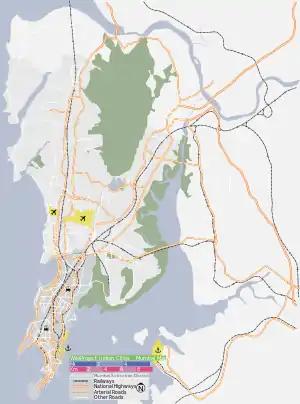Kala Ghoda
Kala Ghoda (IPA:Kāḷā Ghōḍā, lit. 'Black Horse') is a crescent-shaped art district in the city of Mumbai, India.
Kala Ghoda Art Precinct | |
|---|---|
Arts District | |
 The Kala Ghoda Statue | |
 Kala Ghoda Art Precinct Location of Kala Ghoda in Mumbai | |
| Coordinates: 18.9307°N 72.8331°E | |
| Country | India |
| State | Maharashtra |
| Metro | Mumbai |
| PIN Code | 400032 |

It hosts several of the city's heritage buildings including museums, art galleries and educational institutions like the Chhatrapati Shivaji Maharaj Vastu Sangrahalaya, the Jehangir Art Gallery, the National Gallery of Modern Art, and The Arts Trust - Institute of Contemporary Indian Art.[1]
Each year in February, the area hosts the Kala Ghoda Arts Festival. The area is sandwiched between Mumbai Port's docklands to the east, Regal Cinema to the south, Hutatma Chowk and Flora Fountain to the north and Oval Maidan to the west. The Bombay Stock Exchange is to its north east.
The name Kala Ghoda means Black Horse, a reference to the presence of a black stone statue of King Edward VII (as the then Prince of Wales) mounted on a horse that was built by Jewish businessman and philanthropist Albert Abdullah David Sassoon, although this statue was removed from the precinct in 1965 and subsequently placed inside the Byculla Zoo. A local legend stated that the statues of King Edward and the one of Shivaji on a horse at the Gateway of India came to life after midnight and battled it out on the streets.[2] In 2017, the 'Kala Ghoda' returned to the area with a new statue of a similar looking horse without a rider, being commissioned by the Kala Ghoda Association. The statue, titled 'Spirit of Kala Ghoda' was designed by architect Alfaz Miller and sculpted by Shreehari Bhosle.[3][4]
The Esplanade Mansion, India's oldest surviving cast iron building,[5] is in Kala Ghoda. Formerly known as Watson's Hotel, it was the site where films were introduced to India with a screening of the Lumiere Brothers Cinematograph in 1896. The offices of art publication, Marg, are on the third floor of the historic Army and Navy Building.[6]
Prior to the founding of the Bombay Stock exchange, merchants often traded shares at the junction of Rampart row and Meadow street.[7]
Landmarks
- Esplanade Mansion, once Mumbai's premier and pioneering Watson's Hotel
- Bajaj Art Gallery
- Bombay Natural History Society
- Jehangir Art Gallery and the Pavement Gallery
- Chhatrapati Shivaji Maharaj Vastu Sangrahalaya, the main museum in Mumbai
- National Gallery of Modern Art
- Elphinstone College
- Rhythm House
- Max Müeller Bhavan – Indo-German cultural centre
- Army & Navy Building, housing the Westside shopping store
- David Sassoon Library
- Ropewalk Street
- Knesseth Eliyahoo Synagogue
- Church of St Andrew and St Columba
- Lion's Gate
- K. R. Cama Oriental Institute, Asia's oldest library and research archive exclusively devoted to Indo-Iranian and Zoroastrian studies
- Mumbai University
- Civil and Sessions Court
- The Great Western Building, formerly Admiralty House.
Gallery
- Kala Ghoda Area Landmarks
.jpg.webp) Kala Ghoda Fort
Kala Ghoda Fort Kalaghoda statue at the Jijamata Udyan, Byculla, Mumbai
Kalaghoda statue at the Jijamata Udyan, Byculla, Mumbai Watson's Hotel in Kala Ghoda.
Watson's Hotel in Kala Ghoda. Army & Navy Building in Kala Ghoda
Army & Navy Building in Kala Ghoda Kala Ghoda mural depicting a black horse
Kala Ghoda mural depicting a black horse
References
- "Archived copy". Archived from the original on 6 September 2014. Retrieved 6 September 2014.CS1 maint: archived copy as title (link)
- Revenge of the native - LiveMint
- "Mumbai: Over 50 yrs on, Kala ghoda returns today". The Indian Express. 3 January 2017. Retrieved 8 June 2017.
- "Kala Ghoda in Mumbai gets its dark horse back without King Edward VII". hindustantimes.com/. 3 January 2017. Retrieved 8 June 2017.
- Choudhury, Chitrangada (24 June 2005). "Now listed as 'endangered', Watson's Hotel was once toast of Bombay". Indian Express. Express Group. Archived from the original on 12 June 2013. Retrieved 29 December 2008.
- Marg website Archived 2009-05-07 at the Wayback Machine
- Wacha, Dinshaw. A Financial Chapter In The History Of Bombay City.
External links
| Wikimedia Commons has media related to Kala Ghoda. |